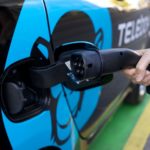 The Financial Times recently argued that electric cars need to arrive as quickly as vaccines if society is to meet its ambitious climate change targets.
The Financial Times recently argued that electric cars need to arrive as quickly as vaccines if society is to meet its ambitious climate change targets.
“Battery cell production is the fundamental rate-limiter slowing down a sustainable energy future. Very important problem,” tweeted Elon Musk.
While battery production is undoubtedly important, a recent study by MIT argues that wider infrastructure improvements are needed to ensure we get more electric cars on our roads. The paper highlights how installing charging stations in residential areas rather than the central locations currently used would have a particular impact.
Electric infrastructure
The researchers aimed to develop a means of identifying the best charging solutions to fit into the daily lives and activities of people. They gathered data from the GPS tracking devices in cars as well as from surveys of the daily driving habits of participants in the Seattle area.
“We examine how different people are moving from location to location throughout the day, and where they are stopping,” the researchers explain. “And from there we’re able to look at when and where they would be able to charge without interrupting their daily travel activities.”
The researchers highlight that the majority of our daily activities can be easily met by the existing range of lower-cost electric vehicles, there are nonetheless occasions when we need to go beyond that range, or alternatively, make more trips than is usual with little time to squeeze recharging into this hectic schedule.
High energy days
These “high energy days” may only happen a few times per year, but they are hugely influential in our decision about whether to go electric or not. As such, it’s important for the infrastructure to exist to address the range issue, even as the range and recharge speed of vehicles continue to improve.
“There are various ways to incentivize the expansion of such charging infrastructures,” the researchers say. “There’s a role for policymakers at the federal level, for example, for incentives to encourage private sector competition in this space, and demonstration sites for testing out, through public-private partnerships, the rapid expansion of the charging infrastructure.”
Of course, an alternative is that local governments provide ample exposure to alternative transportation for those high energy days. Maybe electric car companies could partner with such providers to help drive their own vehicle sales.
Driving demand
The researchers found that increasing the availability of additional long-range vehicles for a few days a year, for instance, meant that a much greater number of homes could meet their transportation needs via a lower-cost electric vehicle. Indeed, the proportion jumped by a whopping 400%.
If you add in fast-charging stations, workplace charging, overnight public charging, and around 10 days of access to additional vehicles, the market would expand to nearly 90% of motorists.
“It’s really important to provide access — reliable, predictable access — to charging for people, wherever they park for longer periods of time near home, often overnight,” the researchers say. “I think it’s so critical to emphasize these high-impact approaches, such as figuring out ways to do that on public streets, rather than haphazardly putting a charger at the grocery store or at the mall or any other public location.”
With electric vehicles likely to be crucial in the reduction of greenhouse gas emissions, the researchers hope that their work will help policymakers provide the infrastructure to support this growth.
“If you have limited funds, which you typically always do, then it’s just really important to prioritize,” they say. “Real-world driving data can not only guide infrastructure and policy planning, but also optimal EV charging management and vehicle purchasing and usage decisions. … This can provide greater confidence to drivers about the feasibility and operational implications of switching to EVs.”